
|  |

|  |
 e-mail: khokar1960@gmail.com Mahakumbha - The SNA International Dance Festival October 27, 2024 The national dance, music and theatre academy - called the Sangeet Natak Akademi - in Delhi, mounted a 6 day juggernaut of dance from October 16-21. Gurus, shishyas, sadhaks, stars, critics and academicians rubbed shoulders with technicians, teachers, tribal and folk artistes. New vocabulary for dance was addressed - like traditional instead of classical and indigenous instead of folk. For over 500 dance related people to meet in one place, for so many days from 9am to 9pm was like going on a pilgrimage. In the end, there was manthan. 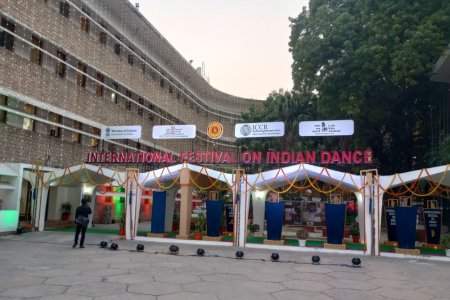 Entry to exhibition in SNA building Day one started at the Shinde Symposium Hall, in Inder Puri area of west Delhi (where hardly ever any such art gathering takes place) and all delegates were daily ferried in buses and cars to the venue, in an orderly fashion. Generally, top names of an institution like the chairman and secretary get named and thanked but valuing all staff that worked seven days is my style so here are those who made it happen too. Recordings/documentation by Rajesh Pande, Shailendra Varan and Ajay Kumar. Boarding, lodging and transportation were looked after by Deepak Joshi, Narvir Singh, Praveen Dureja, Rahul Kumar, Jaipal. The exhibition which Dr. Padma Subrahmanyam inaugurated was curated by Pawan Kant Jha and Jayant Raj Chowdhary. Daily Programme presentation was done by Y. Theba Devi, Rita and Manish Mamagai. The IFID (that's International a festival of Indian Dance) Cell was steered by Shilpa Nagaraju, Ankita Nair, Amita Rana, Shubhi Bhatnagar, Deepak Joshi and Ravinder Kirar. The Chair of Sangeet Natak Akademi, Dr. Sandhya Purecha was the epitome of team work, leadership and motivation. How she came first daily (and all perked up) and left last - all full of verve - is an example in high octane spirit. She chaired many sessions and took all questions and some that could be solved at SNA level, were addressed there and then and others - more policy and contentious ones - she passed on to the ministry, whose senior officials were also there at hand to answer and help like Uma Nanduri, Amita Sarabhai and Aniesh P Rajan. Secretary of the SNA, Raju Das, was like a Rolls Royce car: silent and spiffy in delivering and deciding. He has worked with 4 chairmen, so brings much experience to the table. Day one started with fanfare. To see veteran gurus 80 and above like guru Kalyanasundaram Pillai, Puru Dadhich, Padma Sharma and Padma Subrahmanyam sit through daily 9 hour sessions from 9am to 6pm with one short lunch break was inspirational. Diva Sonal Mansingh, Uma Sharma and Bharat Gupt joined only for specific sessions. 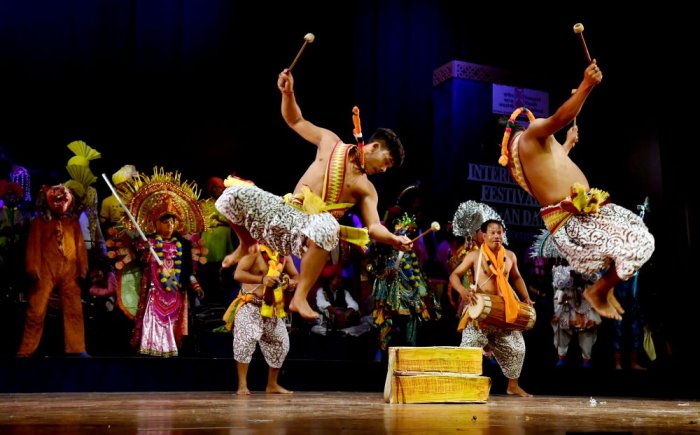 Multi-forms (Photo: Arup Jyoti Khalita) What's the purpose of such a jamboree and what did it achieve? The purpose seemed to get everyone on the same page. All age groups and all shades of dance expressions. The university teacher with the star of the style; the guru with youngsters. The successful and the struggling. Village India and villa India. Add, a sprinkling of diaspora Indians and the palette was a huge feast, bit like the lunch and high tea served every day at the venue. Ministers past and present dropped in and film superstar too. They offered vignettes into their minds and thoughts like when the Culture and Tourism minister Gajendra Singh Shekhawat inaugurated the morning session on the first day, his speech helped understand how and where Indian dance stood globally. In the centre. He gave Indian dance value addition. He made all feel proud of their inheritance. The same evening the Tourism minister Suresh Gopi, also a film star from Kerala, inaugurated the evening shows at Kamani where Mamata Uday Shankar with her group of pretty polly ballet, regaled all. Day 1 session 1 had diva and ex MP Sonal Mansingh heading the session on Odissi with panelists Sharmila Biswas who remained vague as ever! Sonal Mansingh recalled the first national dance seminar of 1958 and how this international one was a mahakumbha. She shared how she first learnt Geeta Govinda from guru USK Rao in Bangalore. She also stressed on what's appropriate or auchitya for children to learn and depict. Gurus are at fault in this case, she shared openly. Madhavi Mudgal used her Anghara festival memory as a centre point and remembered how pioneer Mohan Khokar gave all photos for the festival but didn't give his own (to show how modest he remained). Aruna Mohanty focused on shrinkage of space realities. Guru Mayadhar Raut abstained from attending. Ileana Citrasti showed old visuals of a young Kelubabu teaching and her own processes. Day 1 session 2: Padma Subrahmanyam focused on Roots to Routes. Here's a dancer who is a real scholar too. She shared how her Bharatanrityam came about and why there's still no official recognition. Film clips substantiated her work in the field. Swapnasundari focused on her journey in temple ritual dance resurrection and development. Also, the realities of patronage and performance. Scholar dancer Mahua Mukherjee was a case of too much information compressed in too short a time of delivery. She was excited and delighted with everything she said and her designer clothed husband sang in a husky voice. She mentioned her guru Narotam Sanyal too. Guru Kala Krishna's presentation was first rate, with clarity and content. He used his time efficiently and focused on his guru Nataraja Ramakrishna's lifetime work in Andhra Natyam and Perini Tandava. 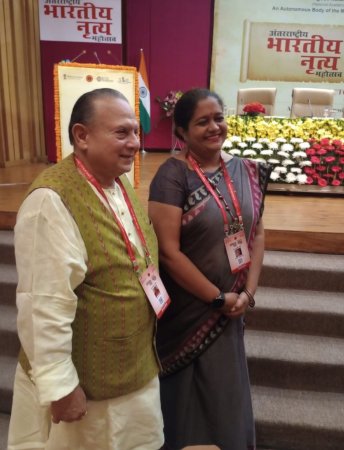 Bharat Gupt, chairman NSD with Sneha Kappanna Dr. Bharat Gupt, the hidden gem of the dance world (because he is more known for theatre and Natyashastra discourse, applicable to both) touched on the fact that Pindibandha is NOT group dancing. Concept of devata and devalakshana also was part of his discourse. He held the audience spellbound. Day 1 Session 3: The Kathak contingent had veterans like guru Uma Sharma in tears, describing how all this experimentation is affecting tradition. Despite a broken hand, she cajoled the audience to not let tradition die. Guru Puru Dadhich enunciated the importance of Natyashastra and jobs. Here is a veteran who is getting his due now in national discourse. Pune senior guru Shama Bhate used excellent film material to showcase her experiments in contemporary works. Saswati Sen took up the road to how Kathak was inspired by Nature, then mythology then micro themes. Why do Kathak dancers not attend other forms or shows? Senior Kathakars Nalini-Kamalini sisters made a forceful case for no caste in dance and how their guru had made aadhyatmik or academic approach to work. Guru Geetanjali Lal remembered Damayanti Joshi, Gopi Krishna and Roshan Kumari. Costumes, riyaz (practice) versus rehearsal (show specific) was the new trend. It was a challenge to perform with different masters. Gyan is dhan not dhan is Gyan! Loosely translated: knowledge is wealth and not wealth is knowledge (as considered today). Dr. Mandavi Singh, shared Raigarh angle and khoj vs. shodh. The 4th session on day one was a mixed bag with guru Jayarama Rao giving the opening address and Dr Rama Pande the academician, talking of abhyaas and adhyamik (practice and theory) being sacrificed for the market. Reality shows are a bane too. Geeta Chandran, in her rapid-fire style, took up points like there were too many practitioners today. Social media was a game changer and there was a increasing lack of audience. Prima donna culture was over now there was democratisation. Ticket culture was missing in Delhi and education in art was needed. She used her time efficiently and effectively. Deepika Reddy next focused on Ashtadevika nayikas and women pining for male stories were passe. Sudha Mohan was high strung in her rendition which focused on skill development and skill development! New education policy also concerned her. Aniesh P. Rajan could be mistaken for a Kerala film actor, for babus normally don't look smart or wear a smile often. He touched upon the role of Akademis and how these grew up with the nation and its trajectories. He touched on social and cultural history. He referred to Rajamannar's speech from the first national dance seminar in 1958. He also felt awards should be given for dancers, not forms, to make the horizon wider. Academician/ dancer Parwati Dutta brings fresh breeze into discourse with her pleasant personality and a smile lurking in the corner. Her visual presentation helped substantiate her discourse, which was about youth, audience, networking and practical teaching. 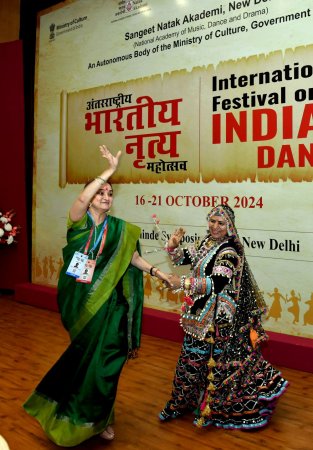 Dr.Sandhya Purecha and Gulabo kalbelia Day 1 session 5: Veteran Joravarsinh Jadav is the vice chairman of the SNA. Old is gold, sits well on him though he sat only one session in the 6 days jamboree. He opened the discussion with focus on his Gujarat model which then went to Vinayak Vishnu Khedekar's Goa model. Basically the agricultural cycle formed the kernel. Gulabo kalbelia won the day with her art to heart talk where she shared how in her community of snake catchers and nomadic life, the girl child was considered a liability and buried alive. She was too. But survived to tell the tale how her mother brought her up to be a world renowned artiste, with Padamshri to boot. She had the audience in tears of both joy and sorrow. Bhagwandas Patel touched on his region which had Adivasis and how drought destroyed much and so colours helped fill the eco system. Parul Shah of Baroda in her presentation on Garba - freshly minted with the UNESCO tag - made everyone dance to her tunes in the end. A full day came to a dancing end! Day 2 session 1: It was on Bharatanatyam with veteran Guru Kalyanasundaram Pillai in chair. He is a darling of all, always in positive mood and blessing all, despite his wheelchair bound frame. He is a true guru and an inspiration at 95! He extolled the devadasi tradition and the nattuvanar parampara. Ananda Shankar Jayant conducted the session and tagged for made in India while the epitome of good grace, veteran Sudharani Raghupati recalled the 1958 seminar and the musical quality of the dance of Bala. She reminisced about the Thanjavur tradition too. Guru Chitra Visweswaran remembered T.R. Jayalakshmi, then guru Ramaiah Pillai who awakened masses with his dances as taught to many. She shared how aesthetics is an ancient construct, not modern. Mysore dancer and yoga-infused Bharatanatyam artiste Vasundhara Doraswamy didn't shed any new light really despite talking on technology. Meenakshi Chittaranjan next was a case in how to use time efficiently, speak clearly and retain audience interest. She also elaborated on how body viewing ought to be by audiences: first see the feet, then torso, body and finally the face. On abhinaya aspect, she stressed they never compromised. Neither the guru nor the dancers. The emotion called shyness was lost now. Audiences were with her totally. Senior guru Premchand Hombal of ex-BHU (Benaras Hindu University) said dance is not about self but the art form itself. He was concerned with converting stone to art. Newspapers might give glowing reviews but the dancer needs to grow all the time. Dr. Ananda Shankar Jayant took to several concerns in conclusion. How, post Covid dance had become more camera conscious. Also, should ALL dance? Students, that is. Shrinking spaces, less audiences and no real funding was the death knell of the dance scene. Amongst solutions, she suggested a cess or percentage in tax for the arts; CSR funding; creation of cultural complexes in gated communities where there's a club house anyway; jobs in railways etc. In the next session, guru Kiran Segal didn't show up to chair the session. Pune guru Nandkishore Kapote shared how dance in films had also helped shape Kathak. Trends of insta to instant culture and dance as part of the new education policy. Kumkum Dhar, with her radio voice, regaled with cinema's old greats and how often the ones in the background danced better than the main heroine! Young star of BN in Chennai, Urmila Satyanarayanan was in her element extolling about how there were experts in everything like social media, marketing, filming but not in dance itself! Quality check was important and how temple and schools can help make dance reach out more. Princess Gopika Varma said how many asked her why she was always doing varnams in which women are always crying, so she thought of new material and works. How to get more students in Mohiniattan in the capital of Bharatanatyam that's Chennai? What to give to audiences without sacrificing the form? Diaspora also decides now what we present. She made solid points. Priya Murle concluded the session with what trends were. The king of Kuchipudi, Raja Reddy with Radha, the quietest among star dancers and gurus of Delhi, took us on a memory trip to Cuba, Sweden, Paris, USA. He remembered Bengt Hager and Sivaramamurthy the iconography expert, who once headed the National Museum. Star of south, in films and dance, Manju Bhargavee of Shankarabharanam film fame, recalled with reverence Guru Vempati Chinna Satyam. She showed film on rupanurupa, or female impersonating male and boy (!), did she look good even with a moustache! Smitha Shastri bespoke of language issues and how to tailor to Bombay audiences. Rajalakshmi Seth touched on renaissance of Kuchipudi and pedagogy. She shared a story when a student was asked "What's classical dance?" Answer: That which is taught in class! (is classical). Senior P. Rama Devi focused on Golakalapam, a forgotten form which was educational, about nine months of maternity. With visuals on biology with x and y chromosomes, she made for an interesting diversion. Alekhya Punjala next shared how one can enrich a repertoire. Just to put pots on head and dance she felt many thought was Kuchipudi. Her guru Uma Rao had made several additions to the characters in Kuchipudi, she averred. 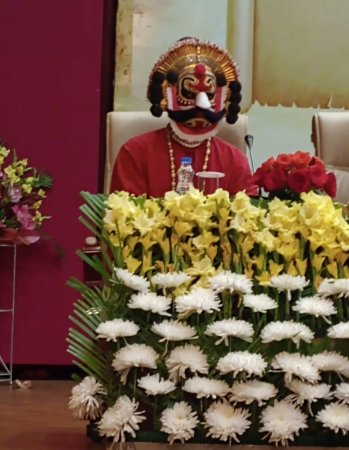 A delegate Session 4 day 2 had veteran Guru of Kathak, Padma Sharma show old film snippets where she had choreographed the famous "paan khaye sainya hamar.." amongst others. She was in element extolling the past. She remembered her guru Lachchu Maharaj with affection. The Wolf Boy, Bharat Sharma said, first of all choreography is an English word. He mentioned Uday Shankar's epic work Kalpana as a biographical work and wanted Almora centre restored. Icon of contemporary dance, Daksha Sheth brought content, connect and context by step by step enunciating what her journey had been. She is she: Direct, deep and dignified. The visuals enhanced her process. Most dancers suffer from self promotion without contextualising the work. She also was humble enough to say let's learn to say I DON'T KNOW what we don't know. Daksha excelled in reaching out to all in the hall and in teaching youngsters discipline and responsibility. Her session was one of the memorable ones. She also proved dancers should speak from experience and not read papers. Many dancers proved to be insipid while reading papers. It didn't connect to most. Young India also has an attention span of a baby monkey; 30 seconds. Then they'd move on to the next thing, cell at best. Sharon Lowen is a gracious, academic lady and led her talk on solo versus group and showed visuals that helped establish her discourse. Th.Chaotombi Singh was innocence personified while recalling the story of evolution of Manipuri. Sashidharan Nair gave the opening address to the next session titled 'Continuity and differentiability' (who thought of these tongue twisters titles, if not grammatically suspect titles!). V.R. Devika defined definitions of Duryodhana through a visual. She reinstated the importance of nomenclature. K.K.Gopalakrishnan, with Theyyam book in hand, talked on the devakoothams/sole female representation. His was a visually rich sharing. Sneha Kappanna next was the unknown star and surprise of the session. Well researched, balanced views and visuals made her exposition on Karnataka traditions a delight to watch and much to learn from. She educated too on how Uttara Kannada was dry; Malinadu was coastal etc. Telangana next was a PR job excellently done by Mamidi Harikrishna who made everyone feel they ought to have been born there! That is to benefit from all schemes and support systems. Tamilnadu next came a cropper with no real content or comment by T. Somasundaram. Another strong speaker was T. Bhaktavatsala Reddy. Day 3! Fatigue setting in? No, but zero involvement as not one speaker in Kathakali session articulated well. MV Narayana as chair tried valiantly (in his accented English) to muster rapport but none of the speakers were clear: mumbling, fumbling, tumbling and rumbling. Language was not the only issue; even their involvement with the subject was zero. Like, they were going through the paces. Only Kannan Parameswaran held ground and salvaged the session. He answered questions well too. This session was the lowest on any scale in the whole festival. What a splendid opportunity lost. The next session by foreigners and assorted diaspora dancers gave all an opportunity to hear divergent voices. There was the energetic Frenchman from Pondicherry, Raghunath Manet, who was all perked up. He shared facts like "we did not copy anyone." He felt that "technology should be at our service not opposite." Irish Sean Gavan, now settled in Netherlands, was a jovial speaker who felt India was becoming more western. He shared he told his students, "It is either my way or the highway!" He said youngsters must respect (teachers and art). Marie Helana Meirmont made a case for global outreach of dance. Lata Surendran was first-rate with crisp content and using the cell mouthed: yatho hasta tatho drishti .... how an ancient shloka was applicable to cell use today. She referred to the digital seduction today. Bang on! Shagun Butani talked of immersive technology while Priyadarshini Ghosh Shome shared how to assimilate virtual with non virtual performances. Guru Gajendra Panda was like a live wire rattling post Covid experiences and how internet helped reach out taking classes in Japan and Bhubaneswar. Sandeep Mahavir took his model of grand productions a la Kingdom of Dreams and how to make these feasible. Gautam Bhattacharya proved to be a tame chair but in the end the Bengal Tiger woke up when the lightsman in him shone, when he took up issues that were his domain of core competency: lights and sound, what to do and what nonsense is being filled today. Mohiniattam next had veteran Vimala Menon. She focused on detrimental changes in costumes and aaharya and youngsters chasing fame. Guru Kshemavathy was most articulate. Deepti Bhalla was academic while Bharati Sivaji proved to be an articulate speaker sharing her journey on how she worked on not making her dance too sweet. Trying new themes and how Kavalam Paniker helped her learn much about aesthetics. She credited Kamaladevi Chattopadhyay for her success too. Mandakini Trivedi had a meaningful presentation with Sunanda Nair concluding on her journey in dance. Day 3 session 4: Legendary guru Darshana Jhaveri in chair started with the story of Manipuri then and how the Jhaveri sisters got to learn from guru Bipin Singh. She recalled the 1958 dance seminar. Star dancer Shovana Narayan started with spunk saying mindset is important as is the media! Else, jungle mein mor nacha kisne dekha (who saw the peacock dancing in forest, unless someone - read light, media - was thrown on it to be seen and shine). While it is motivated by profit , there should be tax incentives for dancers. She also mentioned casteism within the art system and need for school jobs. Narthaki Nataraj said, "I'm a history-making artiste but you don't know my struggles and suffering." She had a whole list of CSR, tax cuts and other measures for the government to consider. Ratikant, son of guru Kelucharan Mohapatra, talked of copyright issues while Vindhuja Menon focused on dance anthropology. Gayatri Kannan's voice was like honey dripping on dusty Delhi ears and she shared her concerns that there were schemes for folk but not so many classical dances in Tamilnadu, a culturally rich state. How there ought to be a state SNA connect. Dance should be a subject in school and ICCR can help reach far and wide. 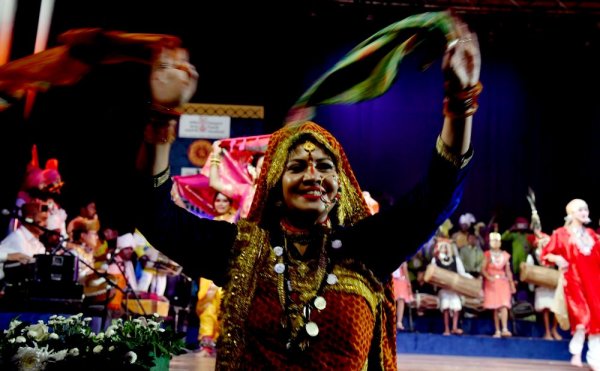 Folk dances (Photo: Arup Jyoti Kalita) Senior folklorist Basanti Bisht - the singing sensation of Uttarakhand - set the tone for next session, the fifth and final of the day. Here's a beautiful, smiling, happy hill lady, Padamshri to boot. She detailed various forms and styles like devnrutya pandavni, veer, mask and agrarian. Jhoda dance was an important cultural connect, she said. Luvkush Dwivedi spoke well on realities of Uttar Pradesh culture scene, dances of Awadh, Purvanchal, Bundelkhand...Farooq Fayaz from Kashmir was gung-ho about changes while being diplomatic. He elaborated that the first to fifth century was Buddhist, viharas and culture built around that. Then fifth to fifteenth century was temple culture. Then Islam. Rauf, he said, is an integral part even in film depiction. He made distinction between elite and commoners. Vidyanand Saraik spoke of the Triveni. Tundup Dorjay brought up the reality of Ladakh culture. And then came a storm! Uma Nanduri, the bright senior officer of the culture ministry. She had a first rate power point presentation that clearly enunciated policies, projects and possibilities. She said there's a paradigm shift with lifestyle choices - Reality shows, Page 3 culture and dance as entertainment. She said catch the bored generation who have time and money and want an experience. They are like latent audiences that need to be caught and brought into dance viewing. She showed "Kalanjali" as a portal for engagement and enterprise. To connect and be on the radar. She clearly woke everyone up. Day 4 session one started with chair Kalavati mentioning different styles of Manipuri. Session chair Yaikhom Hemanta Kumar mentioned 1928 as first dance in Bengal. Guru Premchand Hombal added that it was in 1919 that Tagore first used Manipuri. Priti Patel discourse was on footsteps in legacy. How Bipin Singh shaped up the repertoire from existing traditions of lai haroba, raas. She showed excellent footage too. N.Amusana Devi demonstrated how it was and Laimayum Subhadra Devi sang to drive home her point. Second session of the 4th day had the veteran Sunayana Hazarilal touch on educational importance in dance and also how therapy can help. Jhelum Paranjape took up how as a maths teacher she used Bhaskara's Leela math lessons in dance training. Leela was his daughter and when she would ask him a math question he would answer in riddles and through dance. The contemporary Bharatanatyam icon Chandralekha had made an exceptional production on this called Leela in the mid 1990s. Suchitra Mitra delved on the role of languages and how in Banda Bahadur Singh, she had dovetailed many. Yashoda Thakore focused on rethinking rasa through the mezuvana (closet courtesan). Here the chair made a point: we are a nation that created a science for arts, referring to the Natyashastra. Next session was chaired by Jatin Goswami in which the focus was on Ahom or Assam. What benign people. 92-year-old guru Manik Borbayan showed stylistic features and changes in dance in the sattras. A benign Buddha looking persona enhanced his spiritual aura. Guru Ghanakanta Bora spoke of tradition, how in Assam it was an honour to donate and dedicate a son to the Sattras. Anita Sharma remembered Maheshwar Neog and the 1958 seminar. Karuna Borah shared the landscape of the region. 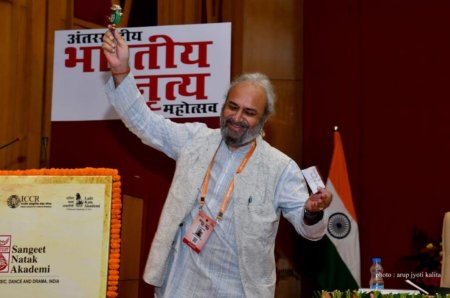 Ashish Khokar seized by the spirit of dance (Photo: Arup Jyoti Kalita) The wakeup call was next when India's major dance writing talents had a session with Nandini Ramani giving the opening address and Kamalini Dutt giving a meaningful talk as chair where she rounded off the history and heritage and how important Documentation was. Archiving is the primary goal. Tapati Chowdhurie referred to dance in the past and how writing helped generations learn. Madhavi Puranam focused on the quarterly - Nartanam - she inherited from V.S. Sarma and Nagabhushan Rao and how, despite gaps in Covid years, she made it reach a milestone. Yours truly started like a rapid fire session which gave an insight into how history can be saved through documentation and what's dance journalism. An area of serious concern was the usage of word 'guru' by youngsters and showcased through a short film the process and product of documentation - the attenDance model, now 25 years old and India's largest dance archives The Mohan Khokar Dance Collection@IGNCA. Sukanya Sankar of Sruti made a neat presentation on role of media and magazines. Sandip Soparrkar, a ballroom dancer and writer, flew in for just his part, perhaps to add sparkle to the proceedings. Next and last session of the day was on Odisha region and had guru Rabindra Atibudhi in opening address, Sanjay Kumar Chaudhary in chair. Launda and Dhobia dances of Bihar were talked about and Deblina Debnath mentioned how Durga Puja had got a UNESCO World Heritage tag.  Members of media panel Day 5 session One had Dr.Bharat Gupt talk on categorisation as important. He said the conflict is not about art. Satvik has been left behind. Guru Shashadhar Acharya the Seraikella chhau master (also, better known as SNA ex-Secretary Helen's hubby!) showcased its history with student Shagun demonstrating. Sadashiv Pradhan espoused on Mayurbhanj chhau. And gave demo of sword dance movements. Margi Madhu on Koodiyattam was sweet to say 5 minutes for a night long art form is nothing but managed well to convey his core concerns which was patronage. Bhagavatamela artiste S. Kumar, brother of late S. Natarajan of Melattur, shared history of the form and his forefathers and how the family has saved the style. While Melattur is much tom-tommed of late, the other tradition of Saliamangalam is forgotten. There was no discourse or focus on that. Keremane Shivananda Hegde made a case for group art that's individual also a la Yakshagana. He shared varieties of Yakshagana from coastal to interiors. Breaking barriers and inclusivity and empowerment was the next session led by veteran Sudharani Raghupathy, an ace in Bharatanatyam field. She wished to break barriers and also desired to document lesser known traditions of Tamilnadu. Next, senior Jayashree Rajagopalan focused through a film on abhinaya and held that the four pillars - angika, vachika, aharya, satvika - must be in proportion. Her main thrust was on aharya. Academic Anuradha Jonalagadda focused on safe spaces and how staying quiet didn't help. She also talked of attitude of dancers to dance. POSH Act and other measures were in place, dancers ought not to suffer in silence. Her subject was deep, even sad, but the visuals were happy making! Flowers and all decorative stuff on screen. Piyal Bhattacharya found Delhi very cold so it seems he wore a fur cap...err, no that's his mane! He spoke well on aspects of intellectual empowerment and inclusivity. NSD head Chittaranjan Tripathi had a good power point presentation and focused on consumer, concept of nation state and the 3S: Samaj, sarkar, sansthan. He desired a National Commission for Art and also a cultural tax, so there's some assured funding. The next session opening address was by senior Odissi dancer Ranjana Gauhar who presented a power point on history of Odissi dance. Very basic. To show only Charles Fabri as saviour and prompter of early Odissi is to do injustice to others like Kalicharan Pattnaik, Mohan Khokar and Dhirendra Nath Pattnaik. Nandini Ramani talked of temples as epic centre, using Sillipadikkaram to demonstrate aesthetics and art. What is auchitya? The grand old masters had shown the way, she stressed. Kuchipudi senior Vanashree Rao said culture is not mere soft power but super. It's a powerful tool. Anupama Kylash focused on transformation. All speakers went back in time, often. Sucheta Chapekar made a good power point presentation. Vyjayanti Kashi didn't show up, while her name was there in session. The 4th session of day 5 was also strong with Prathibha Prahlad in chair. Here's an intelligent artiste, thinker and activist for the arts, promoter too. She took up challenges for the youth and what's shastric? Didactic? Ancient? And how to help an endangered classical form. Urmimala connected it to health and happiness and showcased Sohoni story whereby mental health is addressed through dance. The same was platformed in last year's Natya Kala Conference in Chennai under Rama Vaidyanathan's baton. Activist Arshiya Sethi took up law, copyright issues, the POSH Act. Star Rama Vaidyanathan focused on need to create need-based works not just to survive. Revathi Ramachandran, the stylish ex-Kalakshetra director and hailing from Melattur tradition wanted aesthetics guided by spirituality. Also, to confine variety for creativity. Funding remained an important concern for all. Able Gauri Sharma Tripathi comes off as a grounded Kathakar but that's also because she is khaandani (pedigreed). She used a short film to showcase the Kathak and experimentation peg. The last session was again a mixed bag of Assam indigenous Smorgasbord with Anil Saikia leading the discussion. This is the only day in 6 days of deliberations, I took a break for evening tea so can't report what happened! The political situation in Manipur was also discussed politely. How an art form has suffered was tabled. Sweetly innocent Kuchipudi dancer-reporter Vijay Shankar upset all in the Shinde hall by saying Manipuri faces are such that it is not easy to decipher expressions! Many took umbrage at this remark. He didn't even realise it was politically incorrect to say so. There were more dancers than scholars. That was visible. When dancers did that, there's a pitfall often of historicity and facts. This is the reality today. Dancers have turned spokesmen too. They are articulate and can put together power-point kind of presentations but do they know enough history? Not personalized but factual? Many renowned ones like B.M.Sundaram, J.P.Das, Gowri Ramnarayan, Shyamhari Chakra, Ranee Kumar and Navtej Johar could've added new knowledge and dimensions. The final day first session was on youth affairs. Chair Sandhya Purecha. Jonathan Hollander joined in from New York City, virtually. He is an old India-hand and feet! An afficianado, he has done much to bridge inter cultural bridges and mentor to many. He hosts the biggest and popular dance festival in NYC every summer. He remembered Robert Johnson, the critic. And stated how to look at dance beyond diaspora. 80% comes from individuals. India needs to be proud of its dance, he concluded. 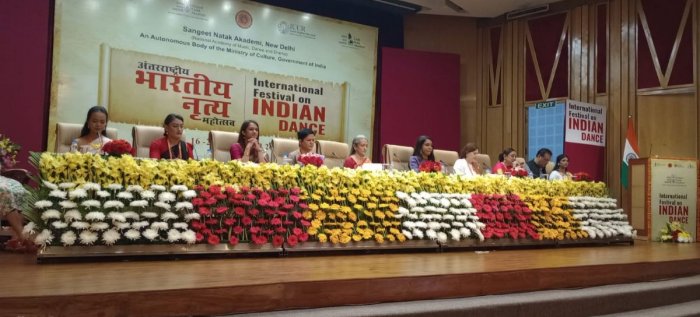 A panel Veteran dancer Priyamvada Sankar next also reminisced about the first 1958 seminar her father the eminent Dr V. Raghavan had steered. She was on a video call from Canada. She recaptured the 1958 seminar memories thus: My teacher Bala Amma invited. Our father Raghavan was instrumental in organizing the BN session. Guru Ellappa Pillai presented Yamini Krishnamurthy. Second memory was Bala ma presenting me! A challenging question was asked whether adavus were important. The doyen of Kathak, Shambhu Maharaj performed next." She also recalled the Garden party where Nehru patted cheek and Indu (Indira Gandhi) smiled. The sun - the chair commented - rises in the East, so Shantha Ratii from Singapore took to the podium first. She shared, "Each one is a gem. Indians have long history of migration. They went for many reasons. My father went to join the India Liberation Army (Subhas Chandra Bose) and then settled there. With the creation of the Singapore National Dance Company, early soft power of India was established. I did my gurukul in Kathakali and Kuchipudi. I returned to Singapore after 25 years then I was humbled. Indian culture had become institutionalized. I added Kuchipudi in Singapore eco system. I have tried to enlarge audience base, not just Indian. Started SPARK mentor program. I created works on calligraphy, and Life as Sketch, Navodaya, on environmental degradation. I amalgamated children's theatre with Kathakali and this helped during and after the Covid period. Nothing gets easier but one gets better (at art)." From Thailand came Awassada Klinsukhon, who spoke on BN in Thai: Why I learn BN? Indian culture has had much impact. Dance has built bridges. Many learnt. All forms - Chhau, Kathak are popular. A student from Mauritius in tertiary school, Praneeta Rama, shared common heritage and spoke on Inclusivity and Empowerment, growing interest in movement. Indian dance is a space where everyone can express. Someone senior in the dance field and academics like Vandana Putanjani Purgus of MGI, with decades of experience would've added weight. Nepal's Sulochana Gopali dressed up beautifully on the occasion in traditional costume which many others did too like from Thailand too. She shared how in 1969, BN started in Nepal. Guru M.K.Saroja had performed for King Birendra in palace and later Pratap Pawar and Birju Maharaj too. That's how Kathak came to the only Hindu rashtra! She held we need guru's grace and India support. Gopali had brevity and conveyed much. Uttara Asha Coorlawala , India's first real modern dancer, who settled in the USA after a shining career in Bombay, shared that Indian dancers "get conflicted in their loyalty. Country one and two? Growing up in India' speaking English, I speak as a curator /mentor and organizer," she emphasised. "At the 1993 Dance Critics Asso. Meet: Most critics in USA didn't understand Indian culture then. We want an informed audience. Culture specific. Not to be just ethnographic specimen, as a novelty." Kathakar Archana Joglekar from New Jersey had much to share on teaching and getting alien audiences in. She shared "how to continue my lineage of guru and mother Asha Joglekar." It was a long struggle and journey. "Little students blossomed in a big way. I feel like a gardener," she said, "to keep young students motivated: program, competition, exam, invitation." From Netherlands on the screen was Leo Spreksel who shared: Indian dance was an inspiration from childhood, also classical dance of Ram Gopal, value system. Saskia Kersenboom, again from The Netherlands, shared her experiences with the devadasi lineage and credited Nandini Ramani family for showing the way. Her book is famous in the realm of devadasi studies. Flamenco dancer from Spain shared her relation with Indian dance, Kerala, Moorish, Africa, Indian influences. She spoke of Kerala Kunnakol. "I wanted to learn. And did start with Aditi of Bombay". Any bad experiences, the Chair asked, and she said, "I'm in love with Indian art forms. I told my mother if you think Flamenco is difficult then come to India! Learn Indian dances. My first guru was a gypsy! In one year, I learnt few steps. " Scholar-singer-dancer-teacher Gayatri Kannan showed the footage on Padma Subrahmanyam dancing to Tchaikovsky's Swan Lake. Anita Srivastava of ex-Pulse UK, shared funding systems. Artistes in UK are fortunate they have National Arts Council, she extolled. Many bodies and established stars help the dance scene and she took examples of the Akademi. Pulse, Bharatiya Vidya Bhavan, Shobhana Jeyasingh, Akram Khan and Aakash Odedra. An able speaker Suraiya of Bangladesh shared how dance was compulsory till tenth in school. Claps from audiences that also wants the same in India. She made for a convincing speaker. The second session was sort of mixed and material too vast. Keremane Hegde steered it with Aangikam bhuvanam yasya vaachikam... angle. Costume designer of Delhi, Sandhya Raman said how meeting Jonathan Hollander changed her life by designing for the west to Indian dance. Working with craft development and costume design is her passion. Costumes should be FIT N FORGET! That was her mantra. She also felt costumes ought to be built in collaboration with dancer. Perception. The first thing everyone sees on stage is the visual appeal. She also made some sweeping comments like: 90% see costumes first not the dancers! Costume is the most important of the four pillars. Next, real costumes from the soil were shared and shown of Yakshagana by youngster Keremane Shridhar Hegde, like crowns, Ganapati, aspect of makeup room called Chowki sitting. It was all a part of tangible heritage. He also spoke on symbolism of colour in makeup - green, white, gold, red. Vandana Pant next, writer and film maker said to remain connected, vendors like her create museums, do sound and light show. She gave the example of starting just 5 years ago with the Kolkata Book fair. It was supported by the British Council. Navid Inamdar talked about set design in theatre. He says he helped create ambience for tribal, folk festival. He took on the treatise Soundarya drishti and wondered when costumes, head dress etc are important, why not sets. Textures help, he said, give strength to the characters on stage. He held theatre was far ahead but not dance. 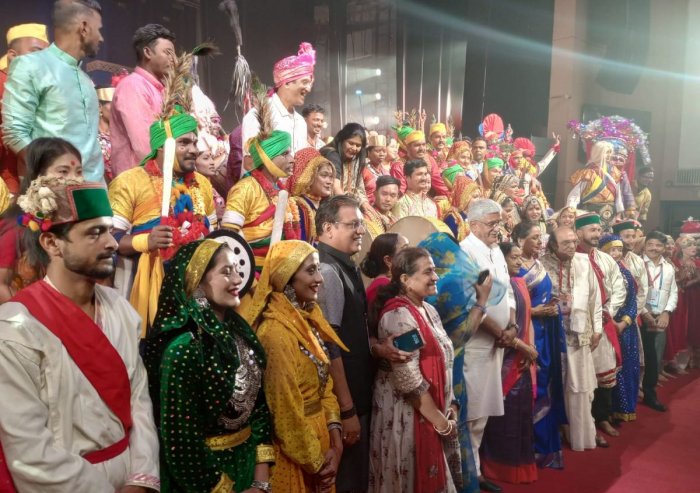 Folk and film dancers The Chair then sat with the Youth brigade in a semi-circle to ask questions and steer the debate. Participating in it were: Gulzar Ahmad Bhatt, Madhushri Haital, Mahati Kannan, Tarini Tripathi, Kerala Kalamandalam Krishnendu, Bhabananda Borbayan, Vishal Krishna, Suhani Dhanki Modi, Akash Mallick, Piyush Raj, Vasant Kiran, Ravi Kumar, Mandakranta Roy, Urmila Maibam, Sayak Mitra, Ganesh Chandanshive. Sunil Sunkara was absent. As 28 median age in India, so all these youngsters are taken, quipped the Chair at the start of the session. She asked each how much they earned. And if Yuva awards (SNA ) helped. Each one went on and on and didn't give clear answers except Vishal Krishna and Vasant Kiran. Akash Mallick said: Dance is a continuous process and he earned ₹7800 and held that awards were an important criteria. VR Vahini said 20k and award motivates. The Sattriya talent was cute as he just smiled saying: EARN? Award helps and gives responsibility, he felt. Vishal Krishna, a happening artiste said: Kathak is puja and it is always a challenge how to pay rent the next month, so teaching is important to earn. Also that organizations behave better with Yuva award tag. Kalamandalam Krishnendu said it gave her 26k and that for her Koodiyattam was life and yes, Yuva SNA recognition helps. Tarini Tripathi, daughter of Gauri Sharma Tripathi and granddaughter of veteran Padma Sharma held that channelizing body was important. Vasant Kiran, an established Kuchipudi dancer and ex University dance dept head (Alliance and Reva) said he earned 50k and that SNA award was a good help. Madhushri from West Bengal held that govt. job was safe and secure, so no issue but folk artistes suffered. Also, getting award is what use if one can't take our work forward? Ganesha Chandan with Tamasha background sang in typical high pitch voice and said as university staff he earned 1.50 lakhs and SNA award gave good standing. Mahati Kannan, upcoming star talent of Chennai-Bengaluru, said dance has potential to educate and the SNA award helps get opportunities. Dr Urmika, Manipuri, never gave precise answers. University teachers think every forum is a class so she went on like a rebel without a pause! She espoused Bhakti rasa and was happy with her good salary and held that SNA award definitely helps. Abhiratan Das from Odisha East was most convincing speaker and down to earth. Award gave more responsibility, he felt. Mandakranta from Bengal again, held that dance gave an emotional connect and was a way of life. She earned 6k and SNA or any award definitely help lots. Ravikumar from Telangana earned 50k and because of the SNA award he said, "I'm called by name Ustad!" Suhani Dhanki Modi from London said she earned from allied works in London 1500 quid (that's slang for British pounds) and in this social media age, award helped. Bollywood was missing in this whole 6 days but mother of all dancers, Hema Malini made up for it by coming for the final session. She spoke from the heart which was refreshing as she says her father took her to dance class on a cycle. Imagine, 3 time MP from Mathura saying that when she is 300 films old. This kind of super mega assembly of dancers will never happen again. Those who stayed away or couldn't come lost out on a great opportunity to meet, bond, understand, interact with many gurus, stars, dancers and youngsters. SNA stands congratulated for pulling off this mega show without any mishaps, delays or hiccups. All went home happy with rasanubhuti and manotripti. How often does that happen? 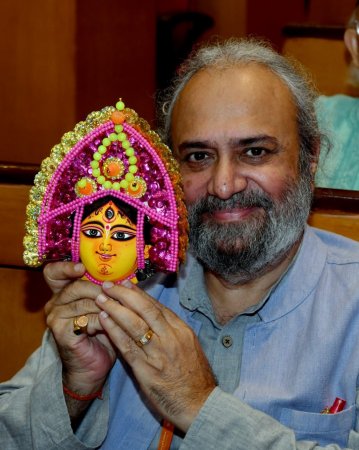 Critic, connoisseur, historian, author, artivist, archivist, administrator and more - editor, columnist and mentor Ashish Khokar remains true to his muse. More on attendance-india.com Responses * Congratulations, sir, on the phenomenal coverage of the Mahakumbha. Beautiful sessions, meaningful talks and informative notes. You are an icon of dance critic. Best wishes Gururaju N (Nov 12, 2024) * The coverage of the Mahakumbha of SNA by Ashish was a commendable exercise in documentation. Son of the legendary master in documentation Late Mohan Khokarji,he has inherited the art and he is not a chip but a CHUNK off the old block. The sheer details of the persons in the background who conducted the festival in the organization apart from the program list are unique. Ashish has to be congratulated for the coverage of the Mahakumbh with appropriate and at times tangential comments which are appropriate. I agree with him that in dealing with history of Odissi mentioning only Dr. Charles Fabri and ignoring the rest was very unfortunate. Yes, Dr. Fabri was the first one to cover Orissi (he called it Orissi) in his Art column for the first time on 5th November 1954 and was a part of the stalwarts who led to the Consolidation of Orissi (now Odissi) and I am happy that Ashish has mentioned the names of Kabichandra Kalicharan Patnaik, Shri Dhiren Patnaik amongst others including Mohanji who literally fought for its recognition. I congratulate Ashish for this marathon and ace coverage. - P. Mohanty Hejmadi (Nov 8, 2024) * Thank you for such extensive, concise, reliable and hands-on coverage. It will be my record of the IFID conference. (Did you ever take a break between the back-to-back 5 sessions per day?!) - Uttara (Nov 8, 2024) * I have witnessed the IFID in Delhi and after reading this I'm surprised to see the appropriateness and exactness of the summary given of the entire festival! Ashish sir, your brain seems to be like a CPU as you remember everything and that too in so much of detail (I wonder how do you do that!). Thank you for this! - Aasawri Singh (Nov 3, 2024) * Crisp and well worded commentary/summary of all sessions by Ashish ji, taking out important points to be highlighted. Nice to be reminded of all greats... when young I used to watch on Doordarshan and read articles in newspapers. - Gaurang Brahmavarti Mishra (Oct 30, 2024) * Certainly the most all encompassing coverage... as great as Sandhya-ji's all time great successful SNA endeavour. Like never before... - Sucheta Bhide-Chapekar (Oct 29, 2024) * Ashishji, it was like seeing the whole event once more. Wonderful, thank you. - Jayaprabha Menon (Oct 29, 2024) * Wonderful, excellent and very vibrant coverage. Analytically very perfect (it is my opinion) and at the same time sweet fountain like lucid language. Thanks to the reviewer, convey my regards to him. - Prof.Mahua Mukherjee (Oct 28, 2024) * Very informative and enriching. Many legends, different traditions. So rich in its experience, all written so elaborately to reach us all. - Archana-Chetana (Oct 28, 2024) Post your comments Please provide your name and email id when you use the Anonymous/blog profile to post a comment. All appropriate comments posted with name and email id in the blog will also be featured in the site. |